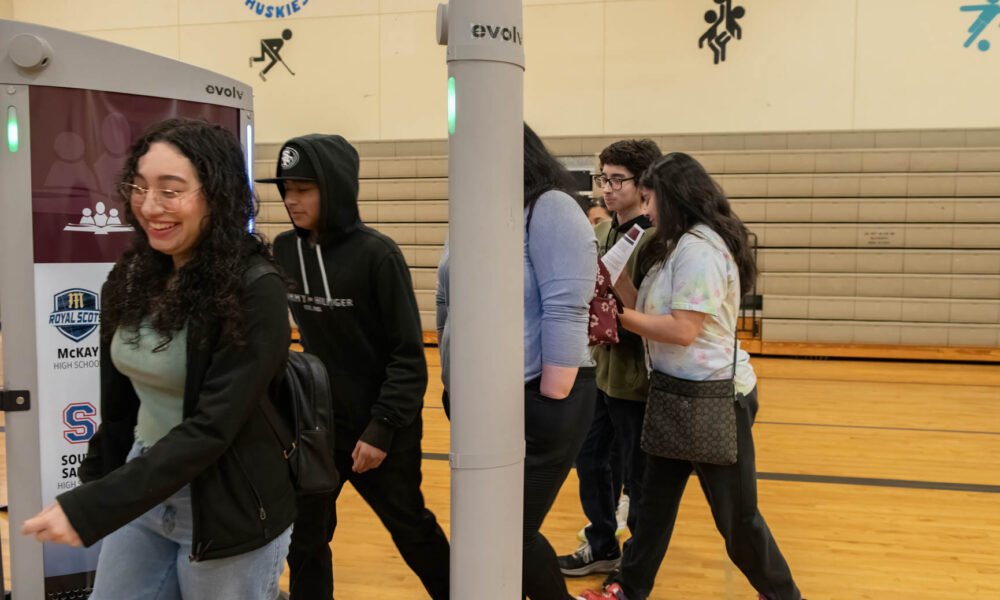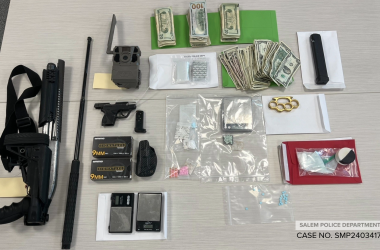A few Salem schools could test weapons detection systems as early as this spring if district leaders decide to begin scanning middle and high school students.
But a rollout to all secondary schools in the Salem-Keizer School District wouldn’t begin until next school year — and Superintendent Andrea Castañeda said she’s still deciding whether and how to move forward with a system.
The current effort to install detectors comes after a March 7 shooting in Bush’s Pasture Park, where a South Salem sophomore is charged with killing a classmate and wounding two other teens. The accused shooter and victim both attended school that morning.
Castañeda said in a meeting the following week with South families that she’d been quietly discussing adding detectors to schools, and brought the conversation into public view earlier than she’d intended following the shooting.
Local schools have seen several incidents in recent years of students arrested with guns on campus, including at South Salem High School last spring, and Stephens Middle School in 2021.
Salem has also seen a rise in gun violence over the past five years, including a growing number of teens who are both perpetrators and victims of shootings.
Vendors demonstrate possible school weapons detectors
Families trickled in and out of the Stephens Middle School gym Friday afternoon for an open house to see two detection systems district leaders are considering buying. They talked to district security workers and vendors about how detectors would be used, and left written comments.
Public reactions to the proposal have been mixed, and the district hasn’t yet analyzed the comments given Friday.
Anitria Major listened at the event with her two children as a vendor for CEIA demonstrated how his company’s scanner would flag a potential weapon, with a red flash over the security gate.
Her son Wade, a Crossler Middle School student, and daughter Joclyn, a freshman at South, said they’d both heard classmates talk about bringing weapons to school.
All three said they thought detectors were a good idea given the prevalence of weapons in society, but said they’d want to make sure school staff are well trained so the process doesn’t lead to racial profiling or students being singled out. Joclyn, who is Black, said although South is a racially diverse school, she still sees racism on campus.
“I would want to know what the oversight is from the people monitoring,” said Major.

Jocelyn Chiu, a parent who attended Friday’s demonstration, said schools should spend resources on staff who can connect with struggling kids, not security systems. She’s spoken to a group of other parents who share her concerns.
“They are not an effective use of our resources as they are unverified, expensive, and show mistrust in our kids. When we treat our children like criminals we’re going to start to see criminals,” she said in written comments she submitted to the district, and also provided to Salem Reporter.
Chiu said she found school district employees at the Friday event disengaged and unwilling to have substantive conversations about security and student needs.
How detectors would work
The two scanners under consideration are from Evolv, a Massachusetts-based security company, and OPENGATE detectors from Ohio-based CEIA USA.
They have slight differences, but both are designed to scan for metals of a particular density and pattern, catching guns and some knives.
With either system, Salem students wouldn’t have to put their backpacks on a conveyor belt or take off jewelry and belts before walking to class, though they might need to pull out laptops or tablets.
Settings can be tweaked so the detectors are more sensitive — likely catching more knives and weapons, while setting off more false alarms — or less sensitive, focused more on detecting guns.

Installing them at secondary schools would cost about $800,000 upfront, Castañeda said in an interview. About half that money could come from a restricted district fund that can’t be used to pay employees.
If they acquire a system, district leaders intend to train existing staff at the school to operate it, said Jesse Davis, security manager. That process would be led by school administrators and on-site security workers who already know students in the building.
That means the ongoing cost to the district would be near-zero, Castañeda said.
A key part of the system would be training school staff on how to act if a detector flags a student. Davis said security workers already check some students for weapons if they receive a tip or concern. They generally try to have the student handle their own belongings, emptying their backpack or turning out their pockets.
“Never would we get to the point where we’re doing pat downs,” he told a family at the event.
Castañeda said in an interview that questions about students being profiled, stereotyped or singled out are “a legitimate concern” and said any screening process the district designs needs to guard against bias.
“One of the things that I like about comprehensive systems is that they are agnostic of the person. One either is or is not carrying firearm density metals, and firearms don’t belong in our schools, no matter who’s carrying them,” she said. “The most important part of implementation is how adults treat young people if an alarm goes off, because it isn’t always a firearm. In that area, we have to be so well trained to ensure that it feels appropriate. It’s not unduly invasive. There’s no aspect of identity markers that are factored into that moment.”
What comes next
Castañeda said that district leaders are still determining how they’ll decide whether to install weapons detectors. The process will involve the school board, but it hasn’t been decided yet whether they would approve a system or leave it to district leaders, which is more typical with contracts and purchases.
She said the comments she’s heard from families generally fall into three categories. Some believe weapons detection is long overdue. Some see it as a regrettable but inevitable part of modern American life. And some are opposed, raising concerns about the impact detectors will have on schools and students.
If the district moves forward, she said she’ll seek student input, including through her cabinet of student leaders. In a recent conversation, a student mentioned to her that weapons screening could be especially challenging for students who are couchsurfing and often carry most of their belongings with them to school. Having to empty out a bag or backpack in front of their peers could be humiliating.
“These are the kinds of specific and actionable insights that we’re going to get from youth,” she said.
Contact reporter Rachel Alexander: [email protected] or 503-575-1241.
SUPPORT OUR WORK – We depend on subscribers for resources to report on Salem with care and depth, fairness and accuracy. Subscribe today to get our daily newsletters and more. Click I want to subscribe!

Rachel Alexander is Salem Reporter’s managing editor. She joined Salem Reporter when it was founded in 2018 and covers city news, education, nonprofits and a little bit of everything else. She’s been a journalist in Oregon and Washington for a decade. Outside of work, she’s a skater and board member with Salem’s Cherry City Roller Derby and can often be found with her nose buried in a book.









